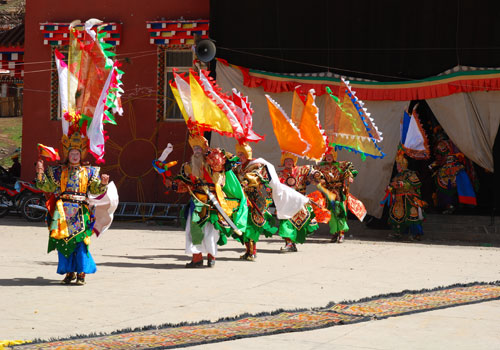
Lamas perform traditional Tibetan dances. (Photo courtesy of Jason Tu)
Jason Tu was exposed to Tibetan culture from an early age, growing up in a little Sichuan town near Tibet Autonomous Region. Starting about four years ago, he began to make frequent trips to Tibetan areas, each lasting between two weeks and six months.
"It's not the destination, but the journey," Jason Tu said of his half-year biking trek through Tibet last year, but the adage could be applied to all of his trips because he seems to discover something new about Tibetan culture each time he heads west.
"At the beginning, I was most interested in the scenery, but then I became fascinated by the simple lifestyle of Tibetan lamas," he said.
In the process, Jason has also forged lasting friendships with lamas across the region, allowing him a first-hand look at a world often off-limits to outsiders. "If you have very good lama friends, they can find things for you," he noted. "If you're just a tourist, the local people are more hesitant."
Jason's latest excursion, lasting a month and a half in May and June, traced the Tibetan-infused areas of Qinghai and Sichuan before heading through Tibet to the city of Lhasa, then crossing the border into Nepal. Despite having traveled these areas before, this trip was a fascinating blend of old friends and new experiences.
He traveled by public transportation about half the time, and hitchhiked for the rest of the trip. "If it's suitable to take a bus, then I do, but much of the time, I have to hitch a ride," he explained. "It makes me closer to the local people; I can hear about how their lives have changed over the years."
On a bus in southern Qinghai, he befriended a group of lamas who invited him back to their monastery. "I didn't know there was a monastery at this location," he explains. "They just picked me up."
After eight months of intense study, the lamas were preparing to celebrate it with traditional Tibetan dances. The lamas, who normally wear plain robes, donned striking, colorful costumes and face paints for the occasion.
These sorts of performances can be found in Lhasa at theatres aimed at tourists; but at a remote monastery nestled in the mountains where visitors seldom tread. Jason felt fortunate to see the dances performed according to local customs and in their traditional atmosphere. "This was a very local production; my lama teacher had to help interpret for me," he explained. "Each dancing step has a special meaning."
From there, Jason headed to the town of Seda, home of the largest Tibetan Buddhist college in the world. The college is nestled in a valley, with separate buildings for men and women, while the lamas' residences radiate outwards, covering the hillsides and creating a unique scene of stacked houses. On top of the hill are innumerable prayer poles. "Seda has the most lamas in one place, 20,000-30,000 lamas study Buddhism here," he said.
